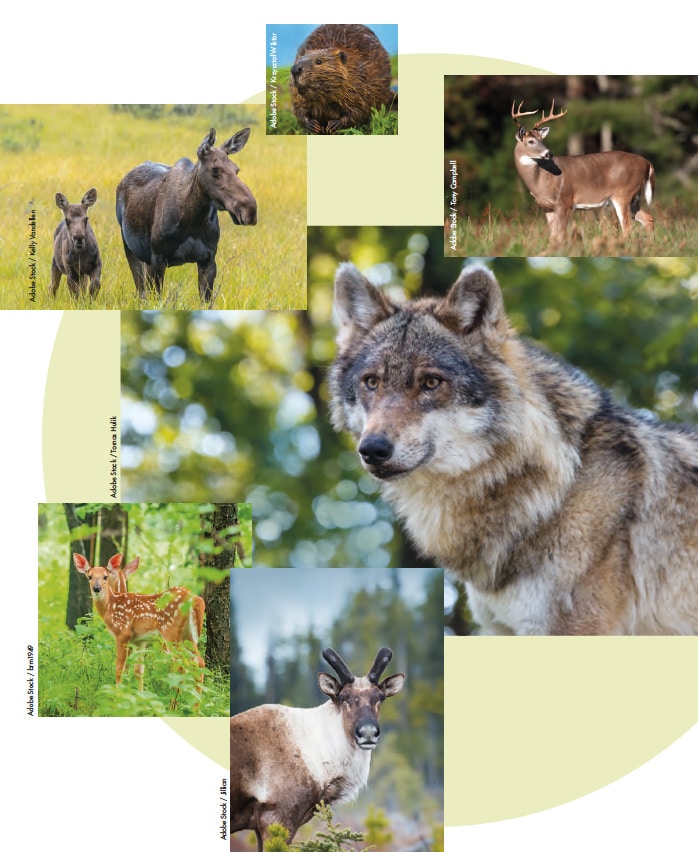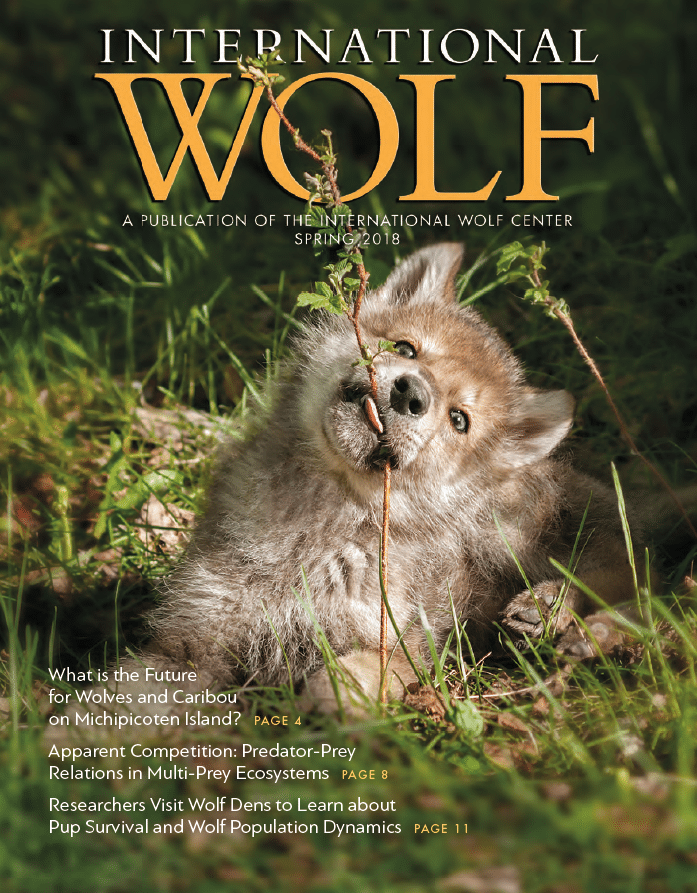狼网 | APPARENT COMPETITION 明显的竞争(双语对照 )
2023年03月12日 05:10:50 来源:国际狼中心 访问量:714次
作者:Debra Mitts Smith
What is apparent competition? The concept deals with predator-prey relations in multi-prey ecosystems. For example: How do wolves impact a white-tailed deer population when there are also moose on the landscape? And how does this impact change when the elk population goes up or down? That concept is analyzed in this article.
什么是明显的竞争?这个概念涉及多猎物生态系统中的捕食关系。例如:当景观上也有驼鹿时,狼是如何影响白尾鹿种群的?当麋鹿数量上升或下降时,这种影响会发生什么变化?本文对这一概念进行了分析。

Apparent competition
明显的竞争
By Debra Mitts-Smith
作者:Debra Mitts Smith
For more than a decade concern has grown about a decline in the number of moose in northeastern Minnesota and woodland caribou in certain parts of British Columbia. Many fear that both these iconic ungulates are on the road to extinction in those areas. Not surprisingly, the predator that shares these habitats—the wolf—has been implicated as a cause behind both declining populations.
十多年来,人们越来越担心明尼苏达州东北部的驼鹿和不列颠哥伦比亚省某些地区的林地驯鹿数量下降。许多人担心这两种标志性的有蹄类动物在这些地区都濒临灭绝。毫不奇怪,与狼共享这些栖息地的捕食者被认为是这两种种群数量下降的原因。
Yet studies of single predator-prey ecosystems such as Isle Royale, where there is one predator (the wolf) and one prey species (the moose) show that instead of the predator rendering the prey species extinct, the predator-prey populations tend to track each other. When the moose population increases, the number of wolves subsequently increases; more moose mean more food for wolves, and more wolves survive. With more wolves surviving, predation on moose increases, resulting in a decline in moose population. As the moose population dips there is less food for wolves, so fewer wolves survive. With fewer wolves hunting, more moose survive into adulthood, and their population begins to increase—and the cycle begins again.
然而,对皇家岛等单一捕食者-猎物生态系统的研究表明,捕食者种群往往会相互追踪,而不是使猎物物种灭绝。皇家岛有一种捕食者(狼)和一种猎物物种(驼鹿)。当驼鹿的数量增加时,狼的数量随之增加;更多的驼鹿意味着狼有更多的食物,更多的狼得以生存。随着越来越多的狼存活下来,对驼鹿的捕食增加,导致驼鹿数量下降。随着驼鹿数量的下降,狼的食物越来越少,所以存活下来的狼越来越少。随着狩猎的狼越来越少,越来越多的驼鹿存活到成年,它们的数量开始增加,周期又开始了。
But ecosystems are complex, and many factors can affect predator-prey numbers, including weather, climate change, poor nutrition, disease, ticks, habitat loss and human hunting. Two recent studies highlight yet another factor that may be contributing to the decline of moose in northeastern Minnesota and caribou in the rain forests of British Columbia.
但生态系统是复杂的,许多因素都会影响捕食者的数量,包括天气、气候变化、营养不良、疾病、蜱虫、栖息地丧失和人类狩猎。最近的两项研究强调了另一个可能导致明尼苏达州东北部驼鹿和不列颠哥伦比亚省雨林驯鹿数量减少的因素。
These two regions are multi-prey ecosystems, meaning that there are multiple prey species available for wolves to hunt and consume. Shannon Barber-Meyer and Dr. L. David Mech explain this in their paper, “White-tailed Deer (Odocoileus virginianus) subsidize Gray Wolves (Canis lupus) During a Moose (Alces americanus) Decline: A Case of Apparent Competition?” In multi-prey systems, when one prey species declines, the predator population can also go into decline (as in a single-prey system) or it can expand its diet by hunting and feed-ing on an alternate prey species. In this case, the predator’s numbers continue to increase because its diet is supplemented by the alternate prey species; at the same time, the predator also continues to feed on the primary prey species, thus reducing it. Wildlife biologists call this phenomenon “apparent competition.” Barber-Meyer and Mech describe this as occurring “when two prey species negatively interact through the sharing of a common predator.”
这两个地区是多猎物生态系统,这意味着有多种猎物可供狼捕食。Shannon Barber Meyer和L.David Mech博士在他们的论文中解释了这一点,“在驼鹿(Alces americanus)衰落期间,白尾鹿(Odocolieus virginianus)补贴灰狼(Canis lupus):一个明显竞争的案例?”在多猎物系统中,当一个猎物物种衰落时,捕食者的数量也可能会减少(就像在一个单一的猎物系统中一样),或者它可以通过狩猎和捕食其他猎物来扩大饮食。在这种情况下,捕食者的数量继续增加,因为它的饮食由替代猎物补充;与此同时,捕食者也继续以主要猎物为食,从而减少了这种现象。野生动物生物学家将这种现象称为“明显的竞争”。Barber Meyer和Mech将这种现象描述为“当两个猎物通过共享一个共同的捕食者而消极互动时”

This story was originally published in the Spring 2018 edition of International Wolf magazine, which is published quarterly by the International Wolf Center. The magazine is mailed exclusively to members of the Center.
这个故事最初发表在2018年春季版的《国际狼》杂志上,该杂志由国际狼中心每季度出版一次。该杂志专门邮寄给中心成员。
Barber-Meyer’s and Mech’s study focused on the predator-prey dynamics of a multi-prey system located in the east-central Superior National Forest in northeastern Minnesota. The wolves there have three prey species available: moose, white-tailed deer, and beavers, with deer being most abundant. From 2006 to 2016, the moose population in this region decreased by 55 percent, from approximately 8,900 to 4,000. The investigators sought to determine whether wolf numbers also fell, or whether wolves supplemented their diets by eating more of an alternate prey source, in this case, deer. The biologists compared wolf numbers and diet by analyzing wolf scats before and after the moose decline. To estimate wolf numbers, they tracked and counted radio-collared wolves in the scat study area.
Barber Meyer和Mech的研究重点是位于明尼苏达州东北部苏必利尔国家森林中东部的多猎物系统的捕食动力学。那里的狼有三种猎物:驼鹿、白尾鹿和海狸,其中鹿的数量最多。从2006年到2016年,该地区的驼鹿数量减少了55%,从大约8900只减少到4000只。调查人员试图确定狼的数量是否也有所下降,或者狼是否通过吃更多的替代猎物来源来补充饮食,在本例中是鹿。生物学家通过分析驼鹿衰退前后的狼粪便,比较了狼的数量和饮食。为了估计狼的数量,他们在粪便研究区追踪并计数了有无线电项圈的狼。
Their study revealed that as the moose population declined by more than half, the wolf population almost doubled during the same period (from 23 during 2001-2002 to at least 42 in 2010-2011 and a minimum of 37 in 2012-2013). The wolves’ most common prey were deer (fawns and adults), followed by moose calves and beavers. Barber-Meyer and Mech suspect that wolf numbers did not initially decline along with the dip in moose numbers because of the abundance of white-tailed deer in the study area, suggesting that apparent competition may be at least partly responsible for the continued moose decline. Wolves began eating more deer, and deer sup-ported the higher wolf population.
他们的研究表明,随着驼鹿数量减少了一半以上,同期狼的数量几乎翻了一番(从2001-2002年的23只增加到2010-2011年的至少42只,2012-2013年的至少37只)。狼最常见的猎物是鹿(小鹿和成年鹿),其次是麋鹿幼崽和海狸。Barber Meyer和Mech怀疑,由于研究地区白尾鹿的丰富,狼的数量最初并没有随着驼鹿数量的下降而下降,这表明明显的竞争可能至少是驼鹿数量持续下降的部分原因。狼开始吃更多的鹿,鹿支持了更多的狼。
At the same time, the increased number of wolves did not stop preying on moose calves, which in turn contributed to the continued drop in moose numbers. Wolf numbers, however, did not decline for several years. The results of the Barber-Meyers and Mech study suggest that the wolf-moose-deer relationship may be an example of apparent competition.
与此同时,狼数量的增加并没有停止捕食麋鹿幼崽,这反过来又导致了麋鹿数量的持续下降。然而,狼的数量在几年内并没有下降。Barber-Meyers和Mech的研究结果表明,狼与驼鹿的关系可能是明显竞争的一个例子。
Finally, it should be noted that following the conclusion of this scat study, Barber-Meyer and Mech found that wolf numbers also began to decline. This suggests that the white-tailed deer population, which at first supplemented the wolf’s diet, began to decline because of the increased wolf predation on it. The drop in deer numbers as well as the decreased moose population eventually began to limit wolf numbers.
最后,需要注意的是,在这项粪便研究得出结论后,Barber Meyer和Mech发现狼的数量也开始下降。这表明,由于狼对白尾鹿的捕食增加,最初补充了狼的饮食的白尾鹿种群开始减少。鹿数量的减少以及驼鹿种群的减少最终开始限制狼的数量。
A second study, “Experimental Moose Reduction Lowers Wolf Density and Stops Decline of Endangered Caribou,” led by biologist Robert Serrouya investigated the role of apparent competition in the decline and recovery of woodland caribou in British Columbia. Extensive logging opened up forage in the Columbia and Cariboo mountain ranges, triggering an influx of moose into a region once dominated by caribou. Moose are considered an invasive species there; they are also the primary prey of wolves, the main predator in the area. An increase in moose meant more food for wolves. So even though caribou declined, the influx of moose helped sustain the wolf population. Wolves began to consume moose while continuing to feed on, and thus limit, the caribou population. The moose-caribou-wolf relationship suggests a case of apparent competition.
生物学家Robert Serrouya领导的第二项研究“实验性麋鹿减少降低狼密度并阻止濒危驯鹿的减少”调查了明显竞争在不列颠哥伦比亚省林地驯鹿减少和恢复中的作用。大规模的伐木在哥伦比亚和卡里布山脉开辟了饲料,引发了驼鹿涌入这个曾经以驯鹿为主的地区。驼鹿在那里被认为是一种入侵物种;它们也是该地区主要捕食者狼的主要猎物。驼鹿数量的增加意味着狼有更多的食物。因此,即使驯鹿数量减少,驼鹿的涌入也有助于维持狼的数量。狼开始消耗驼鹿,同时继续以驯鹿为食,从而限制了驯鹿的数量。驼鹿-驯鹿-狼的关系表明了一种明显的竞争。
Serrouya and his co-authors identified three possible ways to help the caribou recover:
Serrouya和他的合著者确定了三种可能的方法来帮助驯鹿康复:
1. Reduce or eliminate logging in the caribou range, which would in turn reduce the food supply for the invasive moose. To reverse the adverse effects of deforestation, however, takes time, which the caribou in this region do not have.
1.减少或消除驯鹿范围内的伐木活动,这反过来会减少入侵驼鹿的食物供应。然而,要扭转森林砍伐的不利影响需要时间,而该地区的驯鹿却没有。
2. Reduce the number of wolves, which has been useful in other regions where caribou herds are at risk of extirpation. However, for this to be successful, it needs to be an ongoing process because wolf numbers can quickly recover. Further, the removal of wolves has become controversial.
2.减少狼的数量,这在驯鹿群面临灭绝风险的其他地区很有用。然而,要想成功,这需要一个持续的过程,因为狼的数量可以迅速恢复。此外,清除狼群也引起了争议。
3. The option taken by the Canadian government: manage the moose population. Underlying this option is the concept of apparent competition “which can occur when a novel prey species colonizes a new area, stimulating an increase in the abundance of more predator species.” By removing the moose, one could indirectly reduce the number of wolves. Serrouya and his team used this approach to test whether reducing the moose population to earlier levels would lead to fewer one or wolves, thereby helping caribou recover.
3.加拿大政府的选择:管理驼鹿种群。这种选择的基础是明显竞争的概念,“当一种新的猎物物种在一个新的地区定居时,可能会发生这种竞争,刺激更多捕食者物种的数量增加。”通过移除驼鹿,可以间接减少狼的数量。Serrouya和他的团队使用这种方法来测试将驼鹿数量减少到更早的水平是否会减少一只或几只狼,从而帮助驯鹿恢复。
The team established a “treatment” area and a “reference” area in the Columbia and Cariboo mountain ranges. In the treatment area, they increased human hunting to reduce the moose population. Three caribou herds inhabit that area. The reference area had two caribou herds and no moose reduction. Moose reduction was initiated in 2003, but to understand population trends and dynamics of these three species, the study’s authors collected, evaluated and compared data on caribou, moose and wolf numbers before and after the moose reduction began, from 1992 to 2014.
该团队在哥伦比亚山脉和卡里布山脉建立了一个“治疗”区和一个“参考”区。在治疗区,他们增加了人类狩猎,以减少驼鹿的数量。三个驯鹿群栖息在那个地区。参考区域有两个驯鹿群,没有麋鹿减少。驼鹿减少始于2003年,但为了了解这三个物种的种群趋势和动态,该研究的作者收集、评估和比较了1992年至2014年驼鹿减少开始前后驯鹿、驼鹿和狼的数量数据。
The study revealed that the moose population in the treatment area fell by 70 percent, while there was no decline of moose in the reference area. Wolves in the treatment area also declined due mainly to dispersal, but also to starvation and a low pup-survival rate. The caribou herds continued to decline in the reference area while the largest herd in the treatment area has remained stable for 14 years. Still, the authors point out, the stabilization of a caribou herd, although encouraging, does not signal recovery. Instead, they warn that although limit-ing or reducing the number of moose helped stop the caribou decline, growth and recovery of the caribou most likely will require both habitat protection and a direct reduction of wolves by hunt-ing, trapping or other control measures.
研究显示,治疗区的麋鹿数量下降了70%,而参考区的麋鹿没有下降。治疗区的狼数量也有所减少,主要是由于疏散,但也由于饥饿和幼崽存活率低。参考区的驯鹿群继续减少,而治疗区最大的驯鹿群14年来一直保持稳定。尽管如此,作者指出,驯鹿群的稳定虽然令人鼓舞,但并不意味着复苏。相反,他们警告说,尽管限制或减少驼鹿的数量有助于阻止驯鹿数量的减少,但驯鹿的生长和恢复很可能需要保护栖息地,并通过狩猎、诱捕或其他控制措施直接减少狼的数量。
So are wolves responsible for the decline and possible extinction of the moose in northeastern Minnesota and the caribou in British Columbia? On the surface, these two studies suggest that wolf populations, instead of decreasing as the moose and caribou decrease, are instead increasing and continuing to hunt and consume both moose and caribou. But they also suggest that the underlying cause of the increase in the wolf populations is not increased appetite or ravenous behavior on the part of wolves. Instead, it is the presence of an alternate prey species that helps keep wolves fed and their numbers high. In addition, the mere vulnerability of any of these prey animals to wolves is usually related to other factors including weather, diseases and parasites.
那么,狼是明尼苏达州东北部驼鹿和不列颠哥伦比亚省驯鹿数量减少和可能灭绝的罪魁祸首吗?从表面上看,这两项研究表明,狼的数量非但没有随着驼鹿和驯鹿的减少而减少,反而在增加,并继续狩猎和消费驼鹿和北美驯鹿。但他们也表明,狼数量增加的根本原因并不是狼的食欲增加或贪婪行为。相反,是另一种猎物的存在有助于维持狼的进食和数量。此外,这些猎物对狼的脆弱性通常与其他因素有关,包括天气、疾病和寄生虫。
These studies reveal the complexity of ecosystems where a range of variables are at play, including weather and climate change; disease; the kinds, numbers, and sizes of predator and prey species; human disturbance and destruction of habitat; and hunting and nutrition. The interconnectedness and mutability of these factors underscore the difficulty in trying to understand, disentangle, and reduce or eliminate them to save a species from extinction.
这些研究揭示了生态系统的复杂性,其中有一系列变量在起作用,包括天气和气候变化;病捕食者和被捕食物种的种类、数量和大小;人类对栖息地的干扰和破坏;以及狩猎和营养。这些因素的相互联系和可变性突显了试图理解、理清、减少或消除它们以拯救物种免于灭绝的困难。
The simple answer is not always so simple.
简单的答案并不总是那么简单。
Debra Mitts-Smith is a School of Information Sciences faculty member at the University of Illinois. Her research and teaching focus on visual culture, children’s literature, history of the book, and storytelling. Her book, Picturing the Wolf in Children’s Literature, was published by Routledge in 2010.
Debra Mitts Smith是伊利诺伊大学信息科学学院的一名教员。她的研究和教学重点是视觉文化、儿童文学、书籍历史和讲故事。她的书《儿童文学中的狼》于2010年由劳特利奇出版。

编辑:张惠
评论区
发表评论
评论仅供会员表达个人看法,并不表明网校同意其观点或证实其描述

|

|

|

|

|
郑重声明:本站全部内容均由本单位发布,本单位拥有全部运营和管理权,任何非本单位用户禁止注册。本站为教育公益服务站点,禁止将本站内容用于一切商业用途;如有任何内容侵权问题请务必联系本站站长,我们基于国家相关法律规定严格履行【通知—删除】义务。本单位一级域名因备案流程等原因,当前临时借用网校二级域名访问,使用此二级域名与本单位官网权属关系及运营管理权无关。黑龙江省民间文艺家协会狼文化艺术专业委员会 特此声明。
黑龙江省民间文艺家协会狼文化艺术专业委员会 版权所有
中华人民共和国电信经营许可证 ICP证 京ICP备13002626号-8 京公网安备11010502032087
黑龙江省民间文艺家协会狼文化艺术专业委员会官方网站版权所有 联系地址:哈尔滨市道里区机场路23公里处邮箱:1360781304@qq.com 值班电话:18004606931
北京网笑信息技术有限公司 仅提供技术支持 违法和不良信息举报中心
